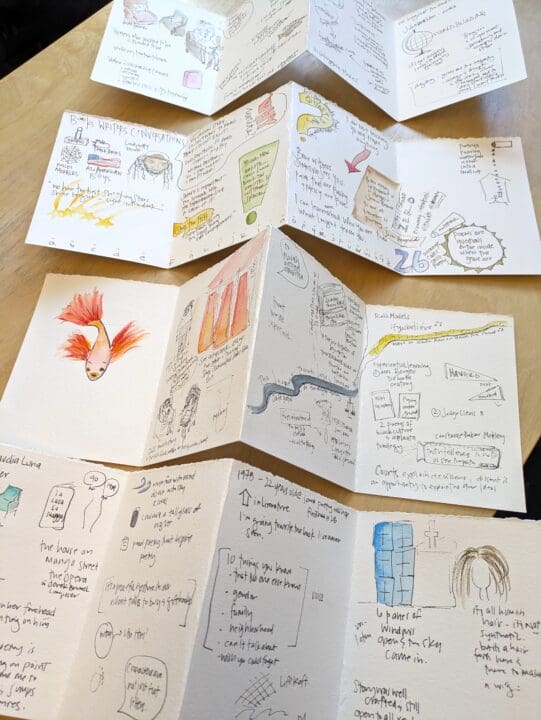
Sketch-Notes from a SAL Patron, Jessica Levine
August 26, 2025
Last season, at the signing line for poet Naomi Shihab Nye’s event, we had a chance to catch up with Jessica Levine, a writer, photographer, and middle school science teacher who has been attending SAL programming for many years.
With her, she was carrying an accordion-folded piece of watercolor paper, with something very exciting inside: sketches and notes from Naomi’s reading and conversation with Lena Khalaf Tuffaha.
Jessica, it turns out, has been making these tiny treasures ever since our evening with Jason Reynolds back in 2023. We fell in love with this creative way of engaging with SAL speakers and their ideas, and we knew we had to chat with Jessica to learn more! Below, we ask Jessica about the origins of these sketchnotes, her favorite events and memories, and we showcase some of her words and drawings from past years.
Can you tell us a little about yourself and how you first discovered SAL events?
I’m a polymath—a dedicated dabbler of many things, including reading! My day job is teaching middle school science, where I actively integrate arts into the classroom, as it is in my own life. I bike commute everywhere in Seattle, including to all the SAL events I’ve been going to for over two decades. I don’t remember how I discovered them—Elliot Bay (in the old basement), or WITS, or simply engaging in the Seattle arts and culture.
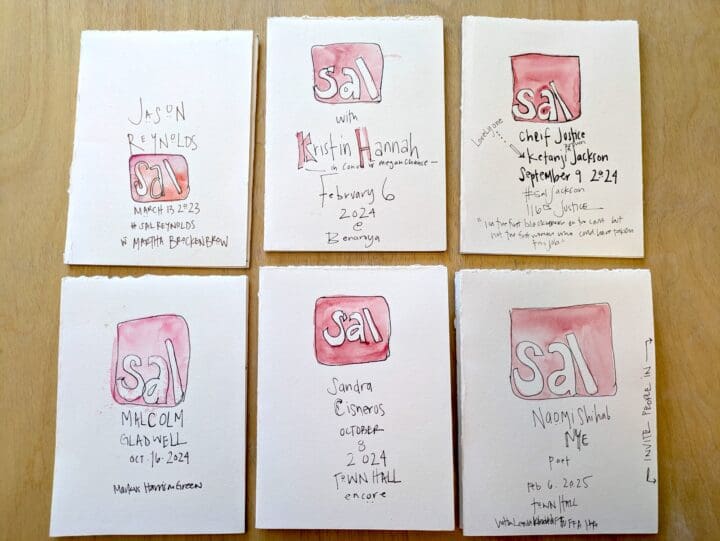
What inspired you to start creating sketches of the events you attend, and how has your approach evolved over time?
I’ve always taken notes at SAL events and other lectures I’d been to. I mentioned I’m a teacher, but really, I’m a lifelong learner. I learn best with a pencil in hand. I still have the orange covered wide ruled composition notebook I used to bring to each one. When I flipped to the first page, just now, I saw it was from Chris Mooney’s talk at Town Hall on September 13, 2005, followed by a talk from Jonathan Kozol on September 28. I’ve included a photo of a fan of a few of the programs that were tucked in there.
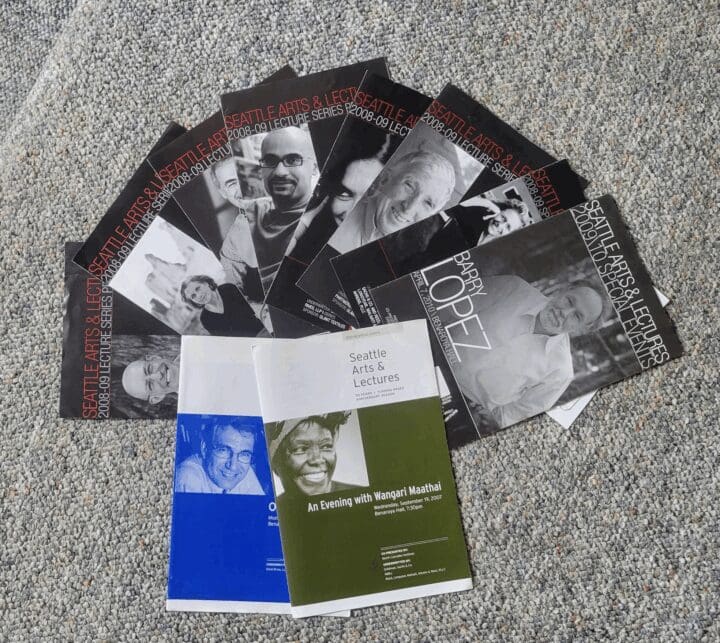
Then, it seemed I documented in words only, and sometimes wrote poems from my notes and quotes. I’ll share this one I love from the late great Barry Lopez and his moving talk in 2010:
Speak the landscape
(notes and rearranged quotes from Barry Lopez’s talk)
I paused here on this road
because I was listening,
and I must
clear
my
head
of
that
before speaking
of this landscape.
You see,
I was listening to the land.
Not the crow, nor the creek,
not the night wind coming across the Sound.
I was listening
to the infinity
of stillness.
I had been groping
in a dearth of language
for an allegiance,
to make acquaintance of my family
by blood with my chosen place
so that they know now
this is my home.
In Pyle’s tangled banks
On Synder’s warm granite
Across Ehrlich’s solace of open spaces
I have found a refuge, akin to Williams.
I am steeped in their western language
our collective geography;
I take possession
compose it
precisely
launch it carefully
so that we are comforted
by the Eden of conversation
in patterns of Palouse,
basin and range.
© Jessica C Levine, 2010
So where did sketching and sketch-noting come from? I’d been sketch-noting with students in the classroom. Visuals help make meaning. But, in the pandemic, my friend invited me to try out a small palette of watercolors and I was hooked. My style is a simple sketch and wash, and I was doing small accordion-style folios for adventures. Thus, bringing my sketch supplies for lectures was a way to continue to focus my attention, to visualize the sound of words, and to make meaning from these moments.
I started with Jason Reynolds in March of 2023. His mixture of poetry and presence was powerful in pictures. I think as I take notes, I imagine myself a writer. Sketching is new enough to me that I still have to remember that I’m sketching for myself and my memories, and not to compare myself to others. For example, I remember when a bike acquaintance, Tessa Hulls, was the official SAL Doodler at Robin Wall Kimmerer. I had sketched at her own Elliott Bay Book Co. reading in April of 2024 for her Pulitzer Prize-winning graphic novel, Feeding Ghosts. When we exchanged images from Kimmerer’s talk it was helpful to remember, it’s about putting marks on a page and that we are all works in progress.
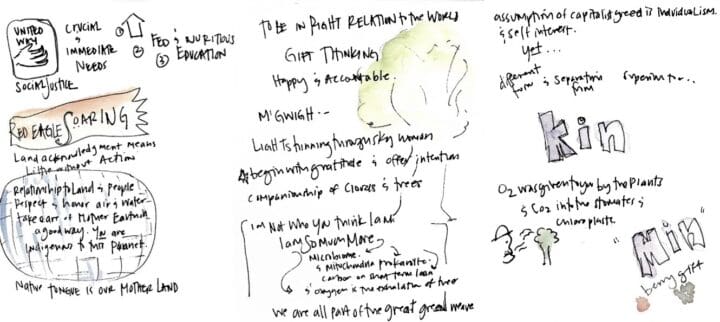
I’m working on sketching people at the podium. I sketched Shelby Natasha who opened for Naomi Shihab Nye, for instance.

Do you have a favorite event or memory from your time at SAL that stands out in your sketches?
It’s hard to pick one. I loved that I jotted down Malcolm Gladwell’s story of perfect air with the HVAC at MOMA. His story alone evoked such a visual. I like the sketch I made of Sandra Cisneros‘ advice to “compost your rage”—it’s a little flower. Looking back at Gabrielle Zevin’s notion of reality privilege. I’ve borrowed that phrase often and am grateful to her for it. I even read Tomorrow, Tomorrow, and Tomorrow again after her talk as I saw the book in a new way. I enjoy going to events with members of my book club.
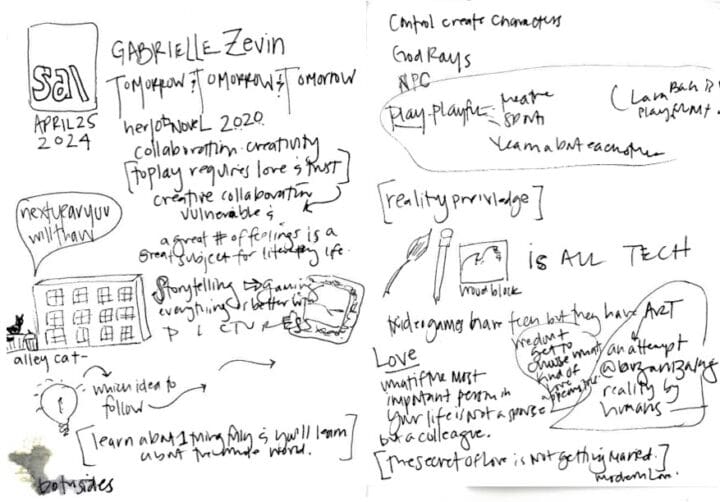
What’s one detail or moment you try to capture in your sketches that others might not notice at the events?
I think I try to hear the poetry of the moments. The way the words are spoken, the sound of the syllabus, and the voice of the author. Not just those who think they are poets, or those in SAL’s Poetry Series. It’s just such a treat to be able to be there. “Live a curious life,” I jotted from Jason Reynold’s talk, “what a glorious experience to be alive.”

Is there a great book you’ve read recently you’d like to recommend?
I’m going to go with my most recent book: John Green’s Everything is Tuberculosis. As a middle school educator, I’ve read all his YA books and love his storytelling. Reading YA, like his novels especially, is like watching a movie in slow motion (and Turtles All the Way Down is way better as a book than a movie!). The Anthropocene Reviewed was a gateway into his nonfiction, and thus Everything is Tuberculosis showcases his thorough research and his compassionate heart. I believe the line between art and science is very thin, and it’s never been a better time to close canyons between perceived dichotomies.
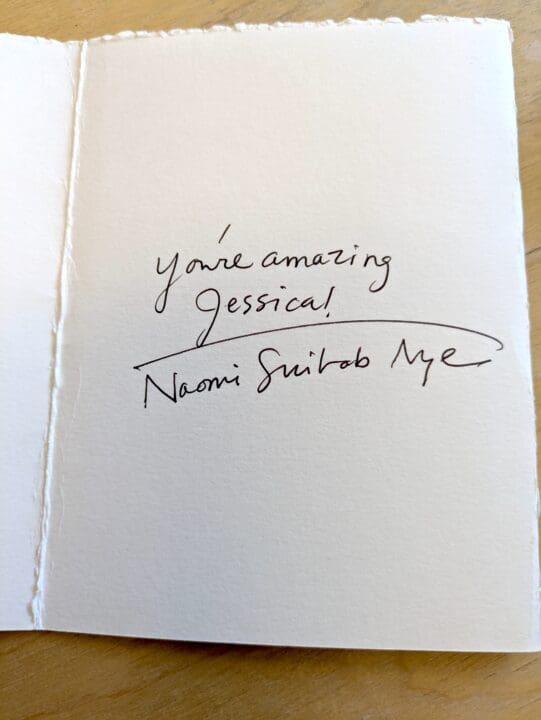
Thank you, Jessica! Our events are brighter because you’re in the hall.
Do you have a creative way of engaging with SAL events? We’d love to hear about your practices!